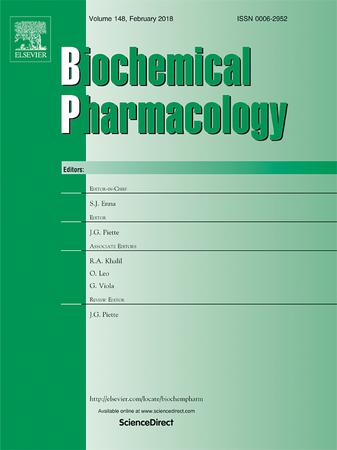Neutralization of IL-33 ameliorates septic myocardial injury through anti-inflammatory, anti-oxidative, and anti-apoptotic by regulating the NF-κB/STAT3/SOCS3 signaling pathway
IF 5.3
2区 医学
Q1 PHARMACOLOGY & PHARMACY
引用次数: 0
Abstract
Septic myocardial injury, a severe sepsis complication linked to high morbidity and mortality, remains a major global clinical challenge. Interleukin-33 (IL-33), a damage-associated pro-inflammatory factor, has been implicated in regulating immune responses and inflammation, but its specific role in septic myocardial injury has not been fully elucidated. This study examined IL-33’s role in septic myocardial injury using Gene Expression Omnibus (GEO) database datasets, alongside in vitro and in vivo experiments. Our results indicated a significant upregulation of IL-33 in septic myocardial injury, as demonstrated in both clinical and experimental settings. Blocking IL-33 significantly enhanced cardiac function and alleviated cardiomyocyte damage. Mechanistic investigations revealed that neutralizing IL-33 mitigates inflammation, oxidative stress, and apoptosis in cardiomyocytes by regulating the nuclear factor kappa B (NF-κB)/signal transducer and activator of transcription 3 (STAT3)/suppressors of cytokine signaling 3 (SOCS3) signaling pathway. Peritoneal macrophages are recognized as a potential origin of IL-33, and targeting IL-33 derived from these cells further reduced cardiomyocyte injury. The study underscores IL-33’s crucial involvement in septic myocardial injury pathogenesis, indicating that IL-33 may serve as a promising therapeutic target.

IL-33的中和通过调节NF-κB/STAT3/SOCS3信号通路,通过抗炎、抗氧化和抗凋亡改善脓毒性心肌损伤
脓毒性心肌损伤是一种与高发病率和死亡率相关的严重脓毒症并发症,仍然是全球临床面临的重大挑战。白细胞介素-33 (IL-33)是一种损伤相关的促炎因子,参与调节免疫反应和炎症,但其在脓毒性心肌损伤中的具体作用尚未完全阐明。本研究利用基因表达综合数据库(Gene Expression Omnibus, GEO)数据集以及体内和体外实验,研究了IL-33在脓毒性心肌损伤中的作用。我们的研究结果表明,IL-33在脓毒性心肌损伤中显著上调,这在临床和实验环境中都得到了证实。阻断IL-33可显著增强心功能,减轻心肌细胞损伤。机制研究表明,中和IL-33通过调节核因子κB (NF-κB)/信号转导因子和转录激活因子3 (STAT3)/细胞因子信号传导3 (SOCS3)信号通路减轻心肌细胞的炎症、氧化应激和凋亡。腹膜巨噬细胞被认为是IL-33的潜在来源,靶向来自这些细胞的IL-33进一步减少心肌细胞损伤。该研究强调了IL-33在脓毒性心肌损伤发病机制中的重要作用,表明IL-33可能作为一个有希望的治疗靶点。
本文章由计算机程序翻译,如有差异,请以英文原文为准。
求助全文
约1分钟内获得全文
求助全文
来源期刊

Biochemical pharmacology
医学-药学
CiteScore
10.30
自引率
1.70%
发文量
420
审稿时长
17 days
期刊介绍:
Biochemical Pharmacology publishes original research findings, Commentaries and review articles related to the elucidation of cellular and tissue function(s) at the biochemical and molecular levels, the modification of cellular phenotype(s) by genetic, transcriptional/translational or drug/compound-induced modifications, as well as the pharmacodynamics and pharmacokinetics of xenobiotics and drugs, the latter including both small molecules and biologics.
The journal''s target audience includes scientists engaged in the identification and study of the mechanisms of action of xenobiotics, biologics and drugs and in the drug discovery and development process.
All areas of cellular biology and cellular, tissue/organ and whole animal pharmacology fall within the scope of the journal. Drug classes covered include anti-infectives, anti-inflammatory agents, chemotherapeutics, cardiovascular, endocrinological, immunological, metabolic, neurological and psychiatric drugs, as well as research on drug metabolism and kinetics. While medicinal chemistry is a topic of complimentary interest, manuscripts in this area must contain sufficient biological data to characterize pharmacologically the compounds reported. Submissions describing work focused predominately on chemical synthesis and molecular modeling will not be considered for review.
While particular emphasis is placed on reporting the results of molecular and biochemical studies, research involving the use of tissue and animal models of human pathophysiology and toxicology is of interest to the extent that it helps define drug mechanisms of action, safety and efficacy.
 求助内容:
求助内容: 应助结果提醒方式:
应助结果提醒方式:


